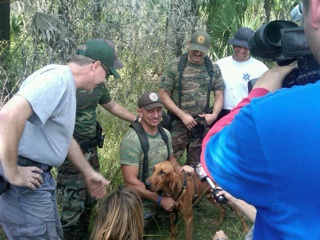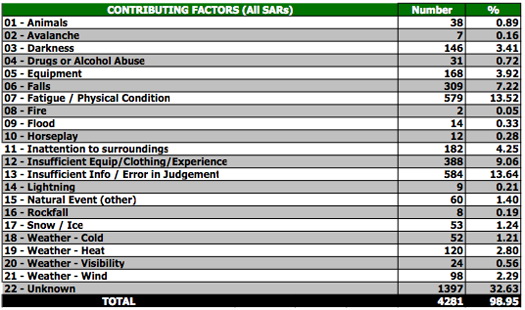
Visitors keep parks’ search teams busy
A group of hikers embarks upon a voyage into a vast wilderness in what is supposed to be a fun few days of camping, stargazing and relaxation amongst nature.
Suddenly, the seemingly harmless journey turns disastrous.
The global positioning system (GPS) unit that the hikers were depending on to navigate through the unknown terrain has malfunctioned, leaving them stranded and helpless.
Now, while this hypothetical situation of lost, careless campers may seem a bit farfetched, such circumstances are an all too familiar reality for search and rescue units of the national parks service today.
More and more, people are venturing into unfamiliar areas, unprepared for what they might face and armed with a false sense of security that comes with carrying an electronic device.
| At right, the team that found and rescued Jamie Mosch in Big Cypress National Preserve. From left, Lt. Harold Minch, Collier County Sheriff’s Office; Deputy Eli Mares, DeSoto Correctional Institution (partially obscured); Sgt. David Pitts, DeSoto Correctional (kneeling); Sgt. Tim Farley, DeSoto Correctional; Justin Andrews, Collier County EMS (National Park Service photo by Bob DeGross). |  |
The truth of the matter is, new technologies, like anything else, are not invincible and believing otherwise can prove to be costly, especially in the exotic backcountry of a national park.
“Some of the issues that we have, and our greatest challenge nationally, is that many people have begun to substitute preparing themselves both mentally and physically to go out into the wilderness,” said Dean Ross, branch chief of Emergency Services for the National Park Service. “They rely upon electronic devices such as cell phones, GPS units [and] spot devices, substituting being prepared for using an electronic device.”
In the age of smart phones, Twitter accounts and the inescapable right-here-right-now attitude that we all live with, such problems should come as a surprise to no one. We have become dependent on new technologies, for better or for worse.
Mother Nature is quite different, however. She has not been transformed into a slave of the machine and needs no devices to operate and no electricity to function, something that visitors of national parks surely realize but fail to fully appreciate.
“With increased technologies I do think we have seen an increase of visitors venturing into areas that perhaps they are not the best prepared for,” said Bob DeGross, chief of Interpretation and Public Affairs for Big Cypress National Preserve in South Florida. “Additionally, with instant communication we often get calls from people that are turned around and, rather than relying on their own skill, they often want the [National Park Service] to respond and assist.”
One park ranger in particular can relate to this last point. John Dill of Yosemite National Park faces situations where a park visitor calls for assistance from their cell phone more than he’d like to admit.
Yosemite is, after all, one of the most popular parks in the country. With more than three million visitors per year on average, the procedure has almost becomes customary, especially with one-day visitors.
“A lot of problems with day hikers is they’re not as experienced, they’re only walking up a trail for the day…they take a cell phone along and don’t know they should be taking anything else along. They say, ‘its just a trail’…a lot of people just role there eyes [and think] ‘it won’t happen to me,’” Dill said. “They take their cell phone along, they don’t even check to see if they have cell services…and if there is reception they may spend their time calling their buddies in Miami…and when they get in trouble the battery’s dead. This is standard.”
Dill offered a very telling analogy for such carelessness.
“You wouldn’t take the air out of your spare tire to blow up your rubber ducky boat to go fishing. It needs to be left alone.”
In all seriousness though, while these situations can understandably be quite frustrating for park rangers, each call is taken very seriously.
When one is received the rangers gather as much information as they can so as to best assess the missing party’s location.
If there is more than one person in the stranded group the ranger will attain each persons cell phone number and swiftly instruct them to power off all phones not being used for the call so as to conserve as much battery life as possible for the longest amount of time or until the situation is resolved.
“When we get a call the first thing we ask is, ‘how is your battery and reception?’ They often don’t know how to describe the location. They say things like, ‘Oh yeah, I see a big tree,’” Dill Said. “We then ask them binary questions. ‘Okay I want you to face the sun, which way is down hill?’…We walk them through it all so we can narrow [their location] down.”
Most of these situations can get resolved quickly, while others can obviously get more complicated.
“Some people can’t even talk, can’t describe anything,” said Dill in an understanding tone.
Earlier last month, Big Cypress dealt with its own missing persons case. A hunter, Jamie Mosch, 30, became separated from the group he was traveling with and was lost for several days before finally being rescued after an extensive and exhaustive search and rescue mission.
Not surprisingly, an electronic device did play a part in the incident.
“Though Mr. Mosch had experience with hunting in other parts of the country, he was not intimately familiar with the local conditions,” DeGross said. “The situation may have been avoided if Mr. Mosch had been better prepared… The only navigational / communication equipment that he had was electronic, a cell phone. Once the equipment became inundated with water it proved ineffectual.”
To illustrate how big of a problem visitor carelessness has become, one needs to look no further than the National Park Service’s Regional Search & Rescue Report for the calendar year of 2008.
Many details surrounding all search and rescue missions in the national parks can be found in the report, including factors that contributed to every missing persons case.
Besides the category of fatigue / physical condition, of the 22 factors listed, the two that are cited most as contributing most to a person getting stranded are insufficient equipment / clothing / experience and insufficient information / error in judgment.
To put it another way, the majority of cases were not a result of an act of nature, but of a person’s own negligence and lack of preparation. Such carelessness can mean the difference between life and death.
“It is always important to pre-plan. Know the environment you are heading into and know your own skills and limitations,” Ross said. “Resources for how to pre-plan and make better decisions include reading guide books, studying maps, following weather reports and researching web sites about the area you are planning to visit, especially those developed by the agency that manages that area.”
Some parks have implemented policies that are designed to save park visitors from themselves. Mandatory orientation classes and informational sessions on the backcountry of an area are just a couple of examples of ways some parks are trying to help keep people from going astray.
Still, such steps are not mandatory of all national parks, and in many cases not necessary either. Some of the best remedies for staying on course during an outing have been around for a long time, longer than the National Park Service has existed.
“Devices fail in a variety of situations,” DeGross said. “Myself, I prefer to rely on a map and compass as my primary direction finder.”
Playing the part of Lewis and Clark may seem old fashioned, but the bottom line is maps and compasses don’t need batteries and four bars of service to operate. Sometimes simpler is better, not to mention safer.
As for how an ambitious nature enthusiast can tell whether he or she is fit for a journey into a national park, Ross offers a simple test.
“People should ask themselves if they would embark on this adventure if they didn’t have the device. If the answer is ‘no’, then they shouldn’t go.”


Comments are Closed